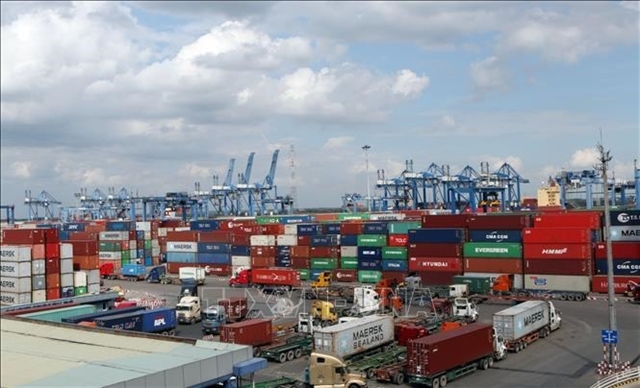
HÀ NỘI — The latest interest rate hike by the US Federal Reversal (Fed) will weigh on the global economy, including Việt Nam, but experts expect impacts of the Fed’s move on the country will not be significant.
The Fed last week raised its benchmark interest rate by half a percentage point, the most aggressive step yet in its fight against a 40-year high in inflation.
Banking and finance expert Cấn Văn Lực, chief economist of the Bank for Investment and Development of Vietnam, told Việt Nam News that the Fed’s move in theory will affect the country’s economic growth, foreign debt payment obligations, exchange rate and foreign investment.
“The Fed’s move may push up the global interest rate and slow global economic growth, which will reduce the demand for Việt Nam’s export goods. It therefore will slow the country’s economic recovery in the context that the import-export turnover per GDP of Việt Nam stays high at around 185 per cent in 2021 and the US is Việt Nam’s top import partner with an import revenue of $96.3 billion in 2021, accounting for 28.6 per cent of Việt Nam’s total export turnover,” Lực said.
In addition, borrowing costs of the Vietnamese Government and its firms will increase when the US dollar strengthens against the Vietnamese đồng in the wake of the Fed’s interest rate hike, Lực said.
“The Fed’s move can also impact foreign investment capital flows, especially foreign indirect investment, because some foreign investors will be concerned about risks and they will withdraw their capital from emerging markets to invest in the US and other developed markets to shelter the risks and enjoy higher interest rates.”
However, Lực forecast the foreign capital withdrawal, if any, will not be much in the Vietnamese market. In the first four months of this year, foreign investors only net sold nearly VNĐ2.5 trillion, equivalent to nearly $110 million, in the Vietnamese stock market, because Việt Nam is still considered an attractive investment market with political and macro-economic stability, and high potential economic growth of some 6-6.5 per cent in the 2022-23 period.
The country’s foreign exchange rate is also expected not to be affected significantly by the Fed’s move.
While most currencies of developing countries have fallen against the dollar in the wake of the Fed’s interest rate hike last week, the đồng has remained unchanged.
The US dollar index continues to rise by 0.5 per cent this week, resulting in depreciation of emerging market currencies, of which the Chinese yuan fell by 1.1 per cent; Indian rupee, 0.6 per cent, and Thai baht, 0.34 per cent. However, the đồng remains stable, hovering around VNĐ22,960 per dollar.
Analysts from the Saigon Securities Incorporation (SSI)’s Research attributed the stabilisation of the đồng to the abundant supply of the greenback in the country thanks to rising trade surplus, foreign direct investment and remittance sources.
Banking expert Dr. Châu Đình Linh said Việt Nam’s foreign reserve hit a record high of nearly $110 billion to date and will keep rising. The value, which is four times higher than in 2015, will be an important buffer to help the country’s economy withstand external shocks and contribute to stabilising the macro-economy and strengthening foreign investors’ confidence.
Meanwhile, according to reports from the General Statistics Office, Việt Nam’s trade surplus to the US and foreign direct investment disbursement in the first four months of this year have been positive, hitting $2.5 billion and $5.9 billion, respectively.
Overseas remittance also rose by 14 per cent to $1.8 billion in the first quarter, according to the State Bank of Vietnam.
Linh estimated the country’s remittances to reach $18.9 billion in 2022 as they have seen an average growth rate of 4.4 per cent per year in the past three years.
Ready to take action
However, experts said the Government needs to be cautious with the Fed’s next moves to take effective measures to minimise adverse impacts as the Fed and other central banks around the world are still tending to tighten monetary policy and increase interest rates.
The Economist Intelligence Unit expects the Fed to raise rates seven times in 2022, reaching 2.9 per cent in early 2023. Starting in June, US officials also plan to shrink their $9 trillion asset portfolio, a policy move that will further push up borrowing costs.
According to Lực, it is necessary to continue strengthening the coordination of monetary and fiscal policies and price management in order to stabilise the macro-economy.
“Flexible monetary policy scenarios should be mapped out to deal with stronger monetary policy tightening that can be taken by the Fed and major central banks,” Lực suggested.
Besides, relevant authorities need to develop a suitable roadmap for price hikes of goods under the management of the State such as petrol, electricity, healthcare and education to better control inflation, he said.
In addition, the Government should monitor and evaluate foreign debt obligations when the Fed raises interest rates in order to give warnings to firms that have foreign debts, besides continually managing the foreign exchange market proactively and flexibly to stabilise the exchange rate. — – VnExpress News
- Reduce Hair Loss with PURA D’OR Gold Label Shampoo
- Castor Oil Has Made a “Huge” Difference With Hair and Brow Growth
- Excessive hair loss in men: Signs of illness that cannot be subjective
- Dịch Vụ SEO Website ở Los Angeles, CA: đưa trang web doanh nghiệp bạn lên top Google
- Nails Salon Sierra Madre
 VnExpress News The News Gateway of Vietnam
VnExpress News The News Gateway of Vietnam




